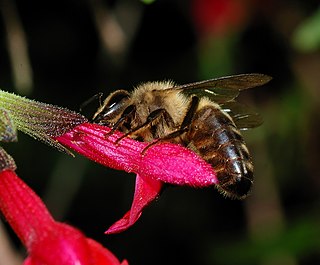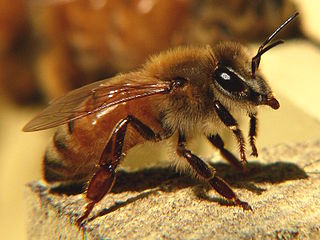
The Buckfast bee is a breed of honey bee, a cross of many subspecies and their strains, developed by Brother Adam, who was in charge of beekeeping from 1919 at Buckfast Abbey in Devon in the United Kingdom. Breeding of the Buckfast bee is now done by breeders throughout Europe belonging to the Federation of European Buckfast Beekeepers (G.D.E.B.). This organization maintains a pedigree for Buckfast bees, originating from the time of Brother Adam.

The European dark bee is a subspecies of the western honey bee, evolving in central Asia and migrating into eastern and then northern Europe after the last ice age from 9,000BC onwards. Its original range stretched from the southern Urals in Russia through northern Europe and down to the Pyrenees. They are one of the two members of the 'M' lineage of Apis mellifera, the other being in western China. Traditionally they were called the Black German Bee, although they are now considered endangered in Germany. However today they are more likely to be called after the geographic / political region in which they live such as the British Black Bee, the Native Irish Honey Bee, the Cornish Black Bee and the Nordic Brown Bee, even though they are all the same subspecies, with the word “native” often inserted by local beekeepers, even in places where the bee is an introduced foreign species. It was domesticated in Europe and hives were brought to North America in the colonial era in 1622 where they were referred to as the English Fly by the Native Americans.

Apis mellifera ligustica is the Italian bee which is a subspecies of the western honey bee.

The Caucasian honey bee is a subspecies of the western honey bee.

The Maltese honey bee, Apis mellifera ruttneri, is a subspecies of the western honey bee, endemic to the Maltese islands which are situated in the Mediterranean Sea.

The East African lowland honey bee is a subspecies of the western honey bee. It is native to central, southern and eastern Africa, though at the southern extreme it is replaced by the Cape honey bee. This subspecies has been determined to constitute one part of the ancestry of the Africanized bees spreading through North and South America.

The Macedonian bee is a subspecies of the Western honey bee. It is found mainly in Bulgaria, North Macedonia, Northern Greece and other places in the Balkans as well. Originally this subspecies was described based on morphological characteristics by Friedrich Ruttner, as were the adami, cecropia and cypria subspecies.
Apis mellifera iberiensis, or the Spanish bee, is a western honey bee subspecies native to the Iberian Peninsula. It is also found on the Balearic Islands.
Varroa sensitive hygiene (VSH) is a behavioral trait of honey bees (Apis mellifera) in which bees detect and remove bee pupae that are infested by the parasitic mite Varroa destructor. V. destructor is considered to be the most dangerous pest problem for honey bees worldwide. VSH activity results in significant resistance to the mites.
Beekeeping is first recorded in Ireland in the seventh century. It has seen a surge in popularity in modern times, with the membership of beekeeping associations exceeding 4,500. The median average number of hives per beekeeper is three hives, while the average honey output per hive is 11.4 kg. The growth in the practice has occurred despite increased pressures on bees and beekeepers due to parasites, diseases and habitat loss.
Apis mellifera cypria(Cyprus honey bee) is a subspecies of the Western honey bee. Its' habitat is the Mediterranean island of Cyprus.

Apis mellifera anatoliaca is a subspecies of Apis mellifera.
Apis mellifera adansonii(Western African bee) is a subspecies of the Western honey bee with probably the largest range of Apis mellifera in Africa, belonging to the A (Africa) Lineage of honey bees. Originally identified by Michael Adansonin in his Histoire naturelle du Seneegal in 1757. Initially the name adsansonii was misapplied to A. m. scutelleta and in particular to the Africanised bees of South America.
Apis mellifera sossimai extending from the west of Ukraine centrally and southwards towards the Caucasus mountains. However in 2011 research from Russia conducted mtDNA analysis showing that the A. m. sossimai was not a separate subspecies, but only an ecotype of the Apis mellifera macedonica subspecies.
Apis mellifera taurica along the north central shores of the Black Sea, in the Crimea. However in 2011 research from Russia questioned the taxonomic status of A. m. taurica citing mtDNA analysis to the north and west of Crimea, which had shown that those regions did not have distinct subspecies, but that their honey bees were at the most ecotypes of previously known subspecies.
Apis mellifera siciliana is known by the common name of the Sicilian honey bee which is endemic to the island of Sicily, Italy in the Mediterranean sea. It belongs to the A Lineage of honey bees from Africa, with close genetic relations to Apis mellifera sahariensis, Apis mellifera intermissa, and Apis mellifera ruttneri.
Apis mellifera unicolor is known by the common name of the Madagascar honey bee, sometimes also called the Malagasy honey bee,, it is endemic to the island of Madagascar.
Apis mellifera syriaca is known by the common name of the Syrian honey bee, sometimes also called the Palestine honey bee.
Apis mellifera meda is known by the common names of the Median honey bee or the Iranian honey bee. Its range covers the non desert areas of most of Iran and Iraq, but also into southeastern Turkey, across northern Syria as far as the coast of the Mediterranean. Colonies have been observed in the Azarbaijan Iranian highlands at elevations up to 3000m. Initially based on morphometric evaluation, but then later confirmed with DNA analysis, they belong to the O Lineage of Apis mellifera.







